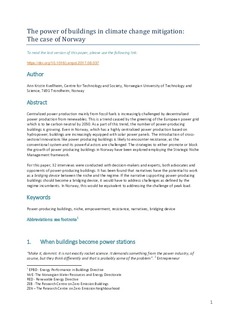| dc.contributor.author | Kvellheim, Ann Kristin | |
| dc.date.accessioned | 2018-03-20T08:15:05Z | |
| dc.date.available | 2018-03-20T08:15:05Z | |
| dc.date.created | 2017-10-29T13:48:45Z | |
| dc.date.issued | 2017 | |
| dc.identifier.citation | Energy Policy. 2017, 110 653-661. | nb_NO |
| dc.identifier.issn | 0301-4215 | |
| dc.identifier.uri | http://hdl.handle.net/11250/2491153 | |
| dc.description.abstract | Centralized power production mainly from fossil fuels is increasingly challenged by decentralized power production from renewables. This is a trend caused by the greening of the European power grid which is to be carbon neutral by 2050. As a part of this trend, the number of power-producing buildings is growing. Even in Norway, which has a highly centralized power production based on hydropower, buildings are increasingly equipped with solar power panels. The introduction of cross-sectoral innovations like power producing buildings is likely to encounter resistance, as the conventional system and its powerful actors are challenged. The strategies to either promote or block the growth of power producing buildings in Norway have been explored employing the Strategic Niche Management framework.
For this paper, 32 interviews were conducted with decision-makers and experts, both advocates and opponents of power-producing buildings. It has been found that narratives have the potential to work as a bridging device between the niche and the regime. If the narrative supporting power-producing buildings should become a bridging device, it would have to address challenges as defined by the regime incumbents. In Norway, this would be equivalent to addressing the challenge of peak load. | nb_NO |
| dc.language.iso | eng | nb_NO |
| dc.publisher | Elsevier | nb_NO |
| dc.rights | Attribution-NonCommercial-NoDerivatives 4.0 Internasjonal | * |
| dc.rights.uri | http://creativecommons.org/licenses/by-nc-nd/4.0/deed.no | * |
| dc.title | The Power of Buildings in Climate Change Mitigation: The Case of Norway | nb_NO |
| dc.type | Journal article | nb_NO |
| dc.type | Peer reviewed | nb_NO |
| dc.description.version | acceptedVersion | nb_NO |
| dc.source.pagenumber | 653-661 | nb_NO |
| dc.source.volume | 110 | nb_NO |
| dc.source.journal | Energy Policy | nb_NO |
| dc.identifier.doi | 10.1016/j.enpol.2017.08.037 | |
| dc.identifier.cristin | 1508666 | |
| dc.description.localcode | © 2017. This is the authors’ accepted and refereed manuscript to the article. Locked until 11.9.2019 due to copyright restrictions. This manuscript version is made available under the CC-BY-NC-ND 4.0 license http://creativecommons.org/licenses/by-nc-nd/4.0/ | nb_NO |
| cristin.unitcode | 194,62,40,0 | |
| cristin.unitname | Institutt for tverrfaglige kulturstudier | |
| cristin.ispublished | true | |
| cristin.fulltext | postprint | |
| cristin.qualitycode | 1 | |

